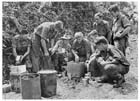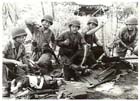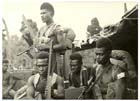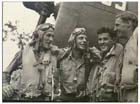The Japanese
Approximately 250,000 Japanese were sent to fight in New Guinea. Most of these men served in the Imperial Japanese Army but there were also a number of naval units present such as the Special Naval Landing Force that fought the Australians in the Battle of Milne Bay. Other naval troops included construction and maintenance units that built and ran a number of shore bases and airbases in the region. The Japanese forces in New Guinea also included an unknown number of Formosan and Korean conscripts (Formosa - now Taiwan - and Korea were then part of the Japanese Empire). These men were usually posted to labour and construction units rather than combat units but as the Japanese position in New Guinea deteriorated many of them were caught up in the fighting.
The Australians
When the Pacific War broke out the Australian Army consisted of two parts: an expeditionary force of volunteers called the 2nd Australian Imperial Force (2nd AIF); and the Citizen Military Force (usually known simply as the Militia) which included conscripts and could not be sent outside Australia or Australian-administered territories such as Papua. In December 1941 most of the 2nd AIF was fighting the Germans and Italians in North Africa as part of the British 8th Army. Therefore much of the initial defence of Australia's possessions in New Guinea fell to the Militia units who were not as well equipped or trained as the units of the 2nd AIF. This situation improved as the AIF units were brought back from North Africa and the Militia units were placed on a more professional footing. New Guinea became the main focus of Australia's war effort between 1942 and 1944 and at least 400,000 Australians served there. This figure includes large numbers of Royal Australian Air Force and Royal Australian Navy perso
nnel whose planes and ships supported the efforts of the soldiers on land.
The Americans
Japan's conquest of Southeast Asia in late 1941/early 1942 made Australia a vital part of the United States' strategy to defeat Japan. The first advance party of American troops arrived in Brisbane on 22 December 1941 and for the next two years Australia became the main base for American forces in the South West Pacific. By 1943 the American presence in Australia reached a peak of 340,000 Army, Air Force and Naval personnel. While not all of these Americans were involved with the fighting in New Guinea many of them did see action there. American engineers and other support troops were sent to Port Moresby in mid-1942 and in September of that year the first American combat units joined the Australians in the battles for Buna and Sanananda. By the end of 1943 American combat troops outnumbered Australian ones in the New Guinea theatre. In August 1944 the Americans withdrew their combat units from New Guinea in preparation for the invasion of the Philippines and left the Australians in charge of all remain
ing operations in the area.
The Papuans and New Guineans
The indigenous peoples of Papua and New Guinea had little say in the war being fought over their lands. For the most part they simply tried to adapt to the difficult circumstances and survive as best they could. Both the Australians and the Japanese employed Papuan and New Guinean men to carry supplies up to the front-line troops and to carry out other forms of manual labour. Local tribesmen also acted as scouts and spies for both sides on occasion. In 1942 the Australians raised a Papuan Infantry Battalion to fight alongside Australian troops and in 1944 this unit was joined by four New Guinea infantry battalions. A number of Papuan and New Guinean guerrilla units were also formed under the command of Australian officers and operated behind the Japanese lines. While some New Guinean men volunteered to work at Japanese bases there is no evidence that the Japanese ever tried to raise indigenous units to fight alongside the Japanese Army.
The New Zealanders
For the first two years of the Pacific War the New Zealanders fought alongside the Americans in the Solomon Islands while the Australians fought alongside the Americans in New Guinea. However by 1944 bomber squadrons of the Royal New Zealand Air Force (RNZAF) were taking part in air raids against the major Japanese base of Rabaul on the Island of New Britain. In September 1944 the Australians took over from the Americans the responsibility for pinning down the Japanese garrisons on New Britain and Bougainville. While the Americans went to the Philippines the New Zealanders stayed behind to work with the Australians. For the rest of the war RNZAF fighter-bomber and bomber squadrons provided air support to Australian ground forces on Bougainville and New Britain.

AWM 030381-04

AWM 016198

AWM 015697

AWM 076702

AWM OG2098
